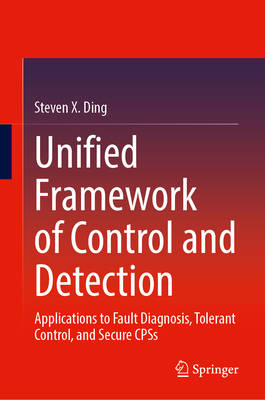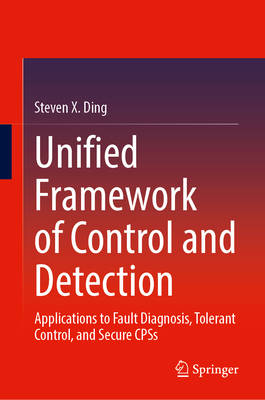
- Afhalen na 1 uur in een winkel met voorraad
- Gratis thuislevering in België vanaf € 30
- Ruim aanbod met 7 miljoen producten
- Afhalen na 1 uur in een winkel met voorraad
- Gratis thuislevering in België vanaf € 30
- Ruim aanbod met 7 miljoen producten
Unified Framework of Control and Detection
Applications to Fault Diagnosis, Tolerant Control, and Secure Cpss
Steven X Ding
Hardcover | Engels
€ 167,95
+ 335 punten
Omschrijving
This book introduces a unified framework for control and detection that brings together concepts from the unified design of control and detection systems and extends them into a comprehensive methodology for analysing and synthesising control, fault diagnosis, and fault-tolerant control systems. A one-to-one mapping from process input-output signals to residual and latent variables forms the foundation of this framework, enabling consistent analysis of control and detection behaviour across a wide spectrum of dynamic systems and supporting the uniform and optimal design of advanced control and diagnosis schemes. This signal subspace based formulation provides an effective means of addressing uncertainties and faults within the residual subspace while simultaneously creating a common platform that integrates traditionally independent research paradigms: model-based, data-driven, and machine learning-aided methods for control and diagnosis. By bridging these domains, the framework fosters new possibilities for innovative and cohesive design methodologies. A particularly impactful application is in secure cyber-physical systems (CPSs), where the effects of cyber-attacks and technical faults are modelled in distinct subspaces, thereby enabling simultaneous fault and attack detection as well as unified strategies for fault-tolerant and resilient control.
Specificaties
Betrokkenen
- Auteur(s):
- Uitgeverij:
Inhoud
- Aantal bladzijden:
- 330
- Taal:
- Engels
Eigenschappen
- Productcode (EAN):
- 9783662724163
- Verschijningsdatum:
- 6/12/2025
- Uitvoering:
- Hardcover
- Formaat:
- Genaaid
- Afmetingen:
- 155 mm x 235 mm

Alleen bij Standaard Boekhandel
+ 335 punten op je klantenkaart van Standaard Boekhandel
Beoordelingen
We publiceren alleen reviews die voldoen aan de voorwaarden voor reviews. Bekijk onze voorwaarden voor reviews.










